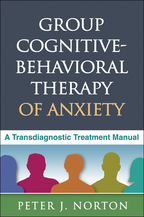Group Cognitive-Behavioral Therapy of Anxiety
A Transdiagnostic Treatment Manual
Peter J. Norton
Hardcovere-bookprint + e-book
Hardcover
orderMay 2, 2012
ISBN 9781462504800
Price: $49.00222 Pages
Size: 6" x 9"
Cognitive-behavioral therapy is highly effective in the treatment of anxiety disorders, regardless of the specific type of fear that is causing difficulties. This practical, hands-on clinical resource presents a proven group treatment protocol for patients with any anxiety diagnosis. Step-by-step guidelines are provided for setting up transdiagnostic groups, using comprehensive assessment to plan and monitor treatment, and implementing carefully sequenced cognitive and behavioral techniques. Clinical examples illustrate the nuts and bolts of intervention across different anxiety disorder presentations. Special features include 19 reproducible handouts and forms that can be downloaded and printed in a convenient 8½“ x 11” size.
“Norton....Has combined his clinical and research expertise to produce a manual that provides an inspiring and practical step-by-step guide aimed at practitioners on how to deliver a 12-week transdiagnostic group treatment for anxiety....All the forms needed to run the group are included in the manual even down to the confidentiality contract. These forms are also available online for readers to download. This book is ideal for any cognitive behavioural practitioner looking to develop their clinical skills and know-how in delivering a novel, effective group intervention for the treatment for anxiety disorders.”
—Behavioral and Cognitive Psychotherapy
“The…organization is straightforward and user friendly….The strengths of this manual are numerous….Ultimately, this well-written text serves as a valuable resource for novice and experienced clinicians. This book offers a research-based rationale, a practical clinical perspective, and accessible instructions for therapeutic delivery. As such, this manual is highly recommended as a guide for the provision of GCBT for pathological anxiety.”
—Cognitive Beaviour Therapy
“Norton has written a practical and accessible book that offers a new treatment option for the millions of individuals who suffer from anxiety disorders. Reading this book will revolutionize your case conceptualization for anxiety disorders, making the most complex, comorbid cases amenable to short-term focused intervention. The transdiagnostic approach is clearly explained and illustrated with rich case examples. Mental health providers with basic expertise in CBT will easily be able to adapt this evidence-based group intervention to their own practice, making treatment more accessible and affordable.”
—Debra A. Hope, PhD, Department of Psychology, University of Nebraska-Lincoln
“A tremendous resource for mental health professionals. Drawing on the latest research showing that common processes cut across various disorders, this book provides an excellent framework for understanding and treating anxiety disorders. Each chapter is a delight to read and guides the reader with clear descriptions and clinical examples. The book is an invaluable training tool for graduate students; I look forward to adopting it for our clinical practica.”
—Lata K. McGinn, PhD, Ferkauf Graduate School of Psychology, Yeshiva University
“This book has sufficient detail for CBT beginners, yet the transdiagnostic perspective offers new insights even for readers with advanced skills. The book presents a fresh approach to case conceptualization rooted in the behavioral and cognitive elements maintaining irrational fears, rather than the specific content of the fear. Norton translates years of clinical research into an approach that is evidence based, efficient, and feasible in most practice settings. He incorporates traditional interventions (exposure, response prevention, and cognitive restructuring) as well as newer approaches, such as motivation enhancement and mindfulness. For each element of treatment, Norton provides a compelling rationale, structured guidance for the therapist, and frank discussion of common problems encountered.”
—Sheila R. Woody, PhD, Department of Psychology, University of British Columbia, Canada
“What if there were a treatment model that allowed you to apply one set of principles across all of the anxiety disorders? After years of research, Norton can confidently show you a simple protocol that succeeds in challenging the thoughts, feelings, and actions that maintain all anxiety—and that is specially designed for groups.”
—Reid Wilson, PhD, Department of Psychiatry, University of North Carolina School of Medicine
Table of Contents
Introduction1. Anxiety Disorders and the Transdiagnostic Perspective
2. Cognitive-Behavioral Therapy within a Transdiagnostic Framework
3. Getting Ready for Treatment: Assessing the Client
4. Session 1: Introduction and Education
5. Session 2: More on Anxiety and the Importance of Thoughts
6. Session 3: Challenging Anxious Thoughts
7. Prior to Session 4: Planning to Confront the Fears
8. Sessions 4 through 9: Exposure
9. Session 10: Getting Back to Thoughts
10. Session 11: Softening Negative Affective Styles
11. Session 12: Relapse Prevention and and Concluding Treatment
12. After Treatment: Assessing Improvement and Moving Forward
